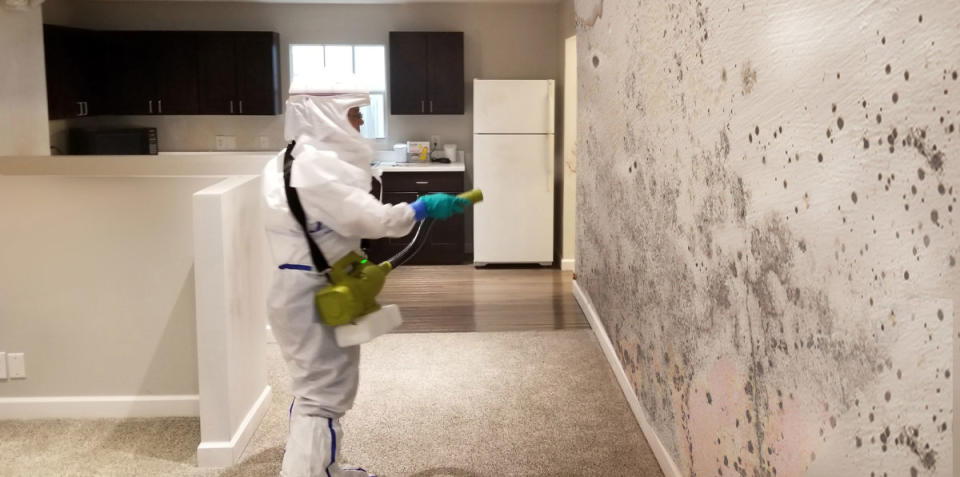7 Things That Mold Mitigation Teams Do to Repair Damage
While some homeowners may feel inclined to handle mold mitigation on their own, it's really important to recognize that this is not always a DIY adventure! Too often, mold growth can often be more extensive and hazardous than initially perceived. When it surpasses the scope of a DIY effort, it's worth calling in reinforcements.
Understanding how professionals tackle mold issues demonstrates how complicated the mold remediation process really is. To gain deeper insights, I spoke with Darren Hudema, Director of Training and Technical Services at PuroClean. The mold removal company's approach involves a meticulous multi-step process for mold abatement, starting with a thorough assessment to gauge mold levels and the extent of fungal growth, plus identifying active moisture sources. From containment to specialized removal techniques and preventive measures, every step aims at ensuring safety and efficacy. Learn more about how the expertise of a professional mold mitigation team can address the complexities of mold remediation and offer peace of mind to property owners.
Related: How to Tell if Mold is Old vs. New Growth (Plus, Tips to Prevent Mold at Home)
Step-by-Step Management of a Mold Infestation
The easiest way to find out was to ask Darren Hudema, Director of Training and Technical Services at PuroClean for more insights. He shared that PuroClean employs a multi-step process to effectively deal with mold damage:
1. Perform a Mold Assessment
Trained IICRC-Certified technicians conduct a thorough inspection of the affected areas to assess the extent of fungal growth and identify the sources of moisture with Infrared cameras, moisture meters, and other state-of-the-art technology.
2. Bring in Specialized Equipment for Containment
Containment, engineering, and administrative controls are implemented to prevent the spread of building mold spores to unaffected areas of the property. "This may involve sealing off the contaminated area and using negative air pressure to contain airborne mold spores," shares Hudema. "Trained technicians also utilized personal protective equipment (PPE) for an added level of protection for health and safety, which is a prime directive for all our franchises. The safety of both our technicians and occupants of buildings is a top priority. During building remediation, our franchises usually ask the occupants to vacate or set up isolation chambers under negative pressure using HEPA air filtration devices for an extended period to prevent entry into the work area and limit any exposure to the affected area being cleaned."
3. Install Air Filtration Devices
High-efficiency particulate air (HEPA) filtration systems are used to capture mold spores from the air, improving indoor air quality during the process of mold remediation.
4. Remove Visible Mold, Treat Mold Spores, and Address Contaminated Materials
PuroClean mold remediation experts use special equipment, and techniques to safely remove toxic mold and contaminated materials from the property. "This may include cleaning and disinfecting surface mold and removing porous materials, such as drywall or carpeting, that cannot be effectively cleaned," Hudema adds.
5. Dry and Dehumidify the Space
After the remediation and cleaning are completed, and a clearance test verifies the work has been accomplished to industry standards, the affected area is thoroughly dried using commercial-strength dehumidifiers to eliminate excess moisture, which helps prevent future mold growth.
6. Make Repairs and Employ Preventive Measures
Specialists may recommend preventive measures, such as repairing roof leaks, fixing foundation issues, or improving ventilation to reduce the risk of future mold problems.
7. Verify a Successful Removal
After the mold removal specialist and any related construction teams have completed the job, the company will conduct a final inspection to ensure that the mold has been effectively removed and the property is safe for occupancy.

PuroClean
Should I contact my insurance company if I find mold?
Without a doubt, yes. One of the most important things you can do first is contact your renters or homeowners insurance company. Many homeowners insurance policies provide coverage for mold damage under certain circumstances, such as when it's caused by a covered peril like water damage from a burst pipe. However, coverage can vary depending on your policy and the specifics of your situation.
Notifying your insurance company promptly allows you to understand your coverage options and any requirements for filing an insurance claim. They can guide you through the steps you need to take, such as documenting the damage and mitigating further harm to your property. Additionally, they can help you find professional mold remediation services and can advise you on how to proceed with mold inspections and the claim process.
Related: 8 Ways to Prevent Water Damage at Home This Winter
What's the cost of mold remediation?
Costs can vary depending on several factors, including the extent of the mold growth, the size of the affected area, the type of mold present, and the accessibility of the mold for remediation. Plan to obtain multiple quotes from reputable mold remediation companies.
On average, homeowners can expect to pay anywhere from a few hundred to several thousand dollars for professional mold remediation services. For minor black mold issues localized to a small area, the cost may be relatively low, ranging from a few hundred to around a thousand dollars; however, for a more extensive mold remediation project, the cost can climb.
Additionally, the cost of mold remediation may also include expenses related to repairing any underlying moisture problems, replacing damaged building materials, and implementing preventive measures to prevent future mold growth and potential health hazards.